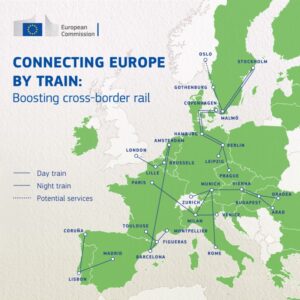The European Commission’s cross border pilot projects are a good idea – but not the way the Commission communicates it
In January 2023 the European Commission announced its 10 cross border railway pilot projects. That the Commission would do this was a commitment in its 2021 action plan to boost passenger rail.

Once in a while the European Commission tries to communicate about these pilot projects – and ridiculously over-sells what they are supposed to do. Today was a case in point with posts like this on LinkedIn and this on Mastodon. And it is not the first time.
But these pilot projects are actually a good idea – just not really in the way the Commission tries to sell them.
To understand what is going on here you need to understand how the European Commission could go about solving cross-border railway problems. The Commission can do this in either a top-down or a bottom-up manner.
Top-down policy making is what the European Commission has attempted to do with the so-called railway packages – legislation at EU level that aims to eliminate the problems on the ground. The 4th Railway Package for example gave new powers to the EU Agency for Railways to type approve new types of train, and hence speed up the process to allow new train designs to be operated EU-wide.
But as my #CrossBorderRail work has shown, a whole slew of problems still exist on the ground.

The pilot projects reverse the European Commission’s approach – these are a bottom-up way to address specific issues at specific borders. Railway companies – either public or private – could propose projects to the Commission that they wished to launch or improve in future, and ask the Commission for help making those projects a reality.
The map shown here shows these projects and – surprise, surprise – there are huge parts of the EU that they do not cover. And indeed plenty of the cross border rail problem points in Europe that are not addressed.
“Why is this route not included?” is a common refrain on social media. Well the answer is – in this case – that no-one in the industry proposed to the Commission to solve it.
But look at a few of the proposed routes (you can find the whole list here), and you start to see how there is something to these pilots.
European Sleeper has its Amsterdam-Barcelona route included as one of the ten, and there are a whole slew of problems to overcome with that – access to rolling stock, non-approval of Vectron locomotives so far in France, no one knowing if RIC carriages can even be used on the Perpignan-Figueras high speed line and what locomotive could haul them.
Routes from Germany and Czechia through Denmark to Sweden are also included, and we know that approval of carriages (currently for the Storebæltsforbindelsen and for the future through the Femern Bælt-tunnelen) are really complicated to get right, and resulted in SJ’s Hamburg-Stockholm night train having to start with too few carriages last year.
And routes between Spain and Portugal are in as well (the cover picture for this piece is the Spain-Portugal border bridge at Valença) – and services at that border are beset by a whole slew of technical and practical problems, meaning that at the moment diesel trains run on a 100% electrified line between Porto and Vigo, and Lisboa-Madrid is a messy and slow trip with at least two changes and takes a lot longer than it should.
So I think you see where I am going with this.
Understanding these problems, and finding ways – practically – to put them right is a very meaningful thing to do. These projects could yet fail, as it is conceivable there is some barrier in each case that is impossible to surmount, but at least we are going to better know what does not work, and why. And it is going to be some time before we know the practical outcomes of these pilots.
So – for the moment – ignore the European Commission’s over-selling of these pilots, and instead focus on the detail. This approach to solving Europe’s railway problems makes sense, most of the pilot routes make sense, and some of these pilots might even work. And if they are to not work, we do not know that yet, and even then we will no doubt learn something through this process. All reasons for a little optimism, if not the euphoria of the Commission’s communications.














Interesting is that these are all “long-distance” projects. Totally missing is the “Kleine Grenzverkehr” (which you explored quite a bit with your campaigns).
Spain/Portugal is probably the easiest to solve; all “usual suspects” have multisystem EMUs in their catalog, some of them based on platforms with partial certifications). All needed is some money and time.